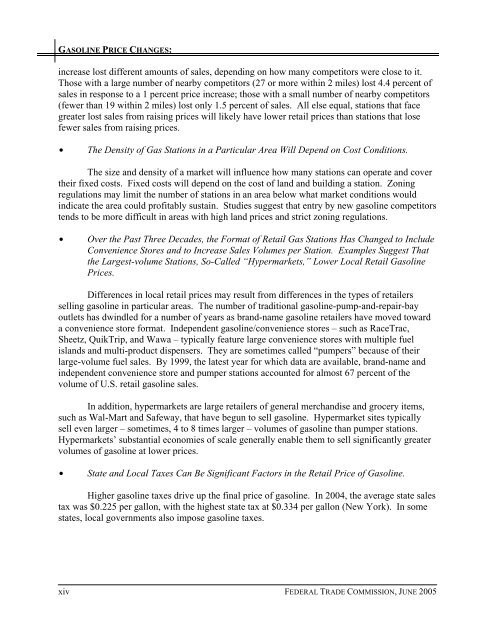Gasoline Price Changes - Federal Trade Commission
Gasoline Price Changes - Federal Trade Commission
Gasoline Price Changes - Federal Trade Commission
Create successful ePaper yourself
Turn your PDF publications into a flip-book with our unique Google optimized e-Paper software.
GASOLINE PRICE CHANGES:<br />
increase lost different amounts of sales, depending on how many competitors were close to it.<br />
Those with a large number of nearby competitors (27 or more within 2 miles) lost 4.4 percent of<br />
sales in response to a 1 percent price increase; those with a small number of nearby competitors<br />
(fewer than 19 within 2 miles) lost only 1.5 percent of sales. All else equal, stations that face<br />
greater lost sales from raising prices will likely have lower retail prices than stations that lose<br />
fewer sales from raising prices.<br />
$ The Density of Gas Stations in a Particular Area Will Depend on Cost Conditions.<br />
The size and density of a market will influence how many stations can operate and cover<br />
their fixed costs. Fixed costs will depend on the cost of land and building a station. Zoning<br />
regulations may limit the number of stations in an area below what market conditions would<br />
indicate the area could profitably sustain. Studies suggest that entry by new gasoline competitors<br />
tends to be more difficult in areas with high land prices and strict zoning regulations.<br />
$ Over the Past Three Decades, the Format of Retail Gas Stations Has Changed to Include<br />
Convenience Stores and to Increase Sales Volumes per Station. Examples Suggest That<br />
the Largest-volume Stations, So-Called “Hypermarkets,” Lower Local Retail <strong>Gasoline</strong><br />
<strong>Price</strong>s.<br />
Differences in local retail prices may result from differences in the types of retailers<br />
selling gasoline in particular areas. The number of traditional gasoline-pump-and-repair-bay<br />
outlets has dwindled for a number of years as brand-name gasoline retailers have moved toward<br />
a convenience store format. Independent gasoline/convenience stores – such as RaceTrac,<br />
Sheetz, QuikTrip, and Wawa – typically feature large convenience stores with multiple fuel<br />
islands and multi-product dispensers. They are sometimes called “pumpers” because of their<br />
large-volume fuel sales. By 1999, the latest year for which data are available, brand-name and<br />
independent convenience store and pumper stations accounted for almost 67 percent of the<br />
volume of U.S. retail gasoline sales.<br />
In addition, hypermarkets are large retailers of general merchandise and grocery items,<br />
such as Wal-Mart and Safeway, that have begun to sell gasoline. Hypermarket sites typically<br />
sell even larger – sometimes, 4 to 8 times larger – volumes of gasoline than pumper stations.<br />
Hypermarkets’ substantial economies of scale generally enable them to sell significantly greater<br />
volumes of gasoline at lower prices.<br />
$ State and Local Taxes Can Be Significant Factors in the Retail <strong>Price</strong> of <strong>Gasoline</strong>.<br />
Higher gasoline taxes drive up the final price of gasoline. In 2004, the average state sales<br />
tax was $0.225 per gallon, with the highest state tax at $0.334 per gallon (New York). In some<br />
states, local governments also impose gasoline taxes.<br />
xiv<br />
FEDERAL TRADE COMMISSION, JUNE 2005
















